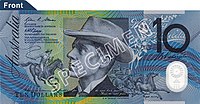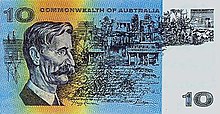Australian ten-dollar note: Difference between revisions
Enlil Ninlil (talk | contribs) No edit summary |
Rescuing 2 sources and tagging 0 as dead. #IABot (v1.2.5) |
||
| Line 35: | Line 35: | ||
|[[File:Australian $10 note paper front.jpg|left|thumb|220px|[[Francis Greenway]] ]] |
|[[File:Australian $10 note paper front.jpg|left|thumb|220px|[[Francis Greenway]] ]] |
||
|[[File:Australian $10 note paper back.jpg|left|thumb|220px|[[Henry Lawson]] ]] |
|[[File:Australian $10 note paper back.jpg|left|thumb|220px|[[Henry Lawson]] ]] |
||
|The people depicted on the paper note issue were [[Francis Greenway]] on the obverse along with public building he helped construct, and [[Henry Lawson]] on the reverse with his poetry and scenes of the outback gold mining town of [[Gulgong, New South Wales|Gulgong]] in the 19th century including the Times Bakery.<ref>[http://www.rba.gov.au/Museum/Displays/1960_1988_rba_and_reform_of_the_currency/australias_first_decimal_currency_notes.html Australia's first decimal currency notes] retrieved 20 January 2008</ref> |
|The people depicted on the paper note issue were [[Francis Greenway]] on the obverse along with public building he helped construct, and [[Henry Lawson]] on the reverse with his poetry and scenes of the outback gold mining town of [[Gulgong, New South Wales|Gulgong]] in the 19th century including the Times Bakery.<ref>[http://www.rba.gov.au/Museum/Displays/1960_1988_rba_and_reform_of_the_currency/australias_first_decimal_currency_notes.html Australia's first decimal currency notes] {{wayback|url=http://www.rba.gov.au/Museum/Displays/1960_1988_rba_and_reform_of_the_currency/australias_first_decimal_currency_notes.html |date=20050822211554 |df=y }} retrieved 20 January 2008</ref> |
||
|} |
|} |
||
| Line 48: | Line 48: | ||
|Obverse design included the sailing ship [[HMS Supply (1759)|HMS ''Supply'']] anchored at [[Sydney Cove]] with the early colony in the background. Above are people who symbolise all who have contributed to Australia, from left the early settlers to right the modern working man. |
|Obverse design included the sailing ship [[HMS Supply (1759)|HMS ''Supply'']] anchored at [[Sydney Cove]] with the early colony in the background. Above are people who symbolise all who have contributed to Australia, from left the early settlers to right the modern working man. |
||
Reverse includes portraits of the [[Australian aboriginal|aboriginal]] population, the main picture is a young native youth with ceremonial paint, and in the background is a [[Morning Star Pole]], other ''Aboriginal artworks commissioned by the Bank'' and a human like figure from [[Dreamtime]].<ref>[http://www.rba.gov.au/Museum/Displays/1988_onwards_polymer_currency_notes/first_polymer.html#top First polymer note] retrieved 24 August 2006</ref> |
Reverse includes portraits of the [[Australian aboriginal|aboriginal]] population, the main picture is a young native youth with ceremonial paint, and in the background is a [[Morning Star Pole]], other ''Aboriginal artworks commissioned by the Bank'' and a human like figure from [[Dreamtime]].<ref>[http://www.rba.gov.au/Museum/Displays/1988_onwards_polymer_currency_notes/first_polymer.html#top First polymer note] {{wayback|url=http://www.rba.gov.au/Museum/Displays/1988_onwards_polymer_currency_notes/first_polymer.html#top |date=20060819142517 |df=y }} retrieved 24 August 2006</ref> |
||
|} |
|} |
||
Revision as of 02:14, 22 October 2016
| (Australia) | |
|---|---|
| Value | 10 Australian dollars |
| Width | 137 mm |
| Height | 65 mm |
| Security features | Window, Watermark |
| Material used | Polymer |
| Years of printing | 1993–94, 1996–98, 2002–03, 2006–2008, 2012–2013, 2015[1] |
| Obverse | |
 | |
| Design | Andrew Barton (Banjo) Paterson |
| Designer | Max Robinson (designer) |
| Design date | 1 November 1993 |
| Reverse | |
 | |
| Design | Mary Gilmore |
| Designer | Max Robinson (designer) |
| Design date | 1 November 1993 |
The Australian ten dollar banknote was issued when the currency was changed from the Australian pound to the Australian dollar on 14 February 1966; it replaced the £5 note which had similar blue colouration. There have been three different issues of this denomination, a paper banknote, a commemorative 1988 polymer note to celebrate the bicentennial of Australian settlement (the first polymer banknote of its kind), and from 1993 a polymer banknote.
According to Reserve Bank of Australia statistics, as at June 2015 there were 116 million $10 notes in circulation, with a net value of $1.161 billion. This was 2% of the cash value of all banknotes in circulation, and 9% of the number of all banknotes in circulation.[2]
Since the start of issue of $10 notes, there have been eleven signature combinations, of which the 1967 issue is the most valued. It was issued for one year only, along with the Coombs/Wilson issue of 1966.
Printing
From 1966–1974 the main title identifying the country was Commonwealth of Australia; there were 470,000,000 notes issued in this period. This was subsequently changed to Australia until the end of issue of paper currency for this denomination in 1993, with 1,265,959,091 of these notes being printed. In the 1988 polymer issue 17,500,000 banknotes were printed and was the new Australia's 10 dollar note.
Design
- Paper note
 |
 |
The people depicted on the paper note issue were Francis Greenway on the obverse along with public building he helped construct, and Henry Lawson on the reverse with his poetry and scenes of the outback gold mining town of Gulgong in the 19th century including the Times Bakery.[3] |
- Polymer note
The polymer note features Andrew Barton (Banjo) Paterson on the obverse with a horse from the Snowy Mountains region, and a wattle plant, also included is his signature. His poetry is in the background. Dame Mary Gilmore is on the reverse with 19th-century heavy transport with horse and cart and verses from her poetry. Her signature is included. A windmill is in the clear window with the raised wavy lines.[4]
- 1988 Commemorative note
 |
 |
Obverse design included the sailing ship HMS Supply anchored at Sydney Cove with the early colony in the background. Above are people who symbolise all who have contributed to Australia, from left the early settlers to right the modern working man.
Reverse includes portraits of the aboriginal population, the main picture is a young native youth with ceremonial paint, and in the background is a Morning Star Pole, other Aboriginal artworks commissioned by the Bank and a human like figure from Dreamtime.[5] |
Security features
The paper design included a watermark in the white field of Captain James Cook, the watermark was also used in the last issue of pound banknotes. A metallic strip, first near the centre of the note, then from 1976 moved to the left side on the obverse of the note. Polymer issue includes a shadow image of the coat of arms which is printed over. Embossing or a raised image in the clear window of wavy lines. Also for this issue fluorescent colouring was added to the serial numbers. A star with four points on the obverse and three on the reverse which join under light. Raised print and micro printing of the poem The Man from Snowy River and the denomination value are included.[6][7]
1988 Commemorative This issue includes an optically variable device of Captain James Cook, who first mapped Botany Bay.
References
- ^ http://banknotes.rba.gov.au/resources/for-collectors/serial-numbers
- ^ "DISTRIBUTION-CIRCULATION AND PRODUCTION STATISTICS, AS AT END JUNE 2015". banknotes.rba.gov.au. Reserve Bank of Australia. Retrieved 31 December 2015.
- ^ Australia's first decimal currency notes Template:Wayback retrieved 20 January 2008
- ^ http://banknotes.rba.gov.au/australias-banknotes/banknotes-in-circulation/ten-dollar/
- ^ First polymer note Template:Wayback retrieved 24 August 2006
- ^ http://banknotes.rba.gov.au/counterfeit-detection/security-features-overview
- ^ http://banknotes.rba.gov.au/banknote-features/
- Ian W. Pitt, ed. (2000). Renniks Australian Coin and Banknote Values (19th ed.). Chippendale, NSW: Renniks Publications. pp. 170–172. ISBN 0-9585574-4-6.
